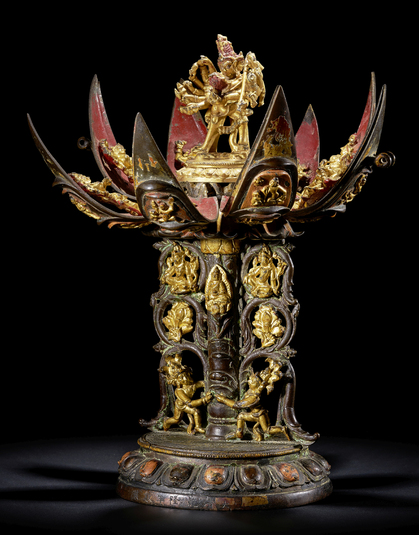
Item: Chakrasamvara (Buddhist Deity) - (Krishnacharin Tradition)
| Lineages | Buddhist |
|---|---|
| Material | Metal, Painted Face/Hair |
| Collection | Private |
Classification: Deity
Appearance: Semi-Peaceful
Gender: Male
Chakrasamvara and Vajrayogini from the tradition of Krishnacharin.
The Central figure appears to be the four faced and twelve armed Chakrasamvara embracing Vajrayogini with her left leg pressing to the ground and the right leg wrapped about the waist of Samvara. It is the stance of Vajrayogini that identifies the tradition as Krishnacharin. The Luipa and Ghantapa traditions depict the Yogini with both legs wrapped around the waist of Samvara.
Typically the immediate inner mandala circle for Samvara has either four of six female dakini figures separated by four nectar filled vases. Depending on the lineage and textual system the dakini figures can have either two or four arms. The six figure configuration is more unusual and rare in art. The form of Samvara is also different and typically has six arms instead of twelve. This can be seen with the Nyima'i Dorje tradition of the Nine Deity Chakrasamvara found in the Mitra Gyatsa collection of deities.
An inner circle of eight figures is highly unusual. It is far more likely that the eight female figures belong to the mandala of Hevajra. It is very possible that the Lotus Mandala had lost at some point in time the central Hevajra figure and a replacement Chakrasamvara was located and attached.
The Hevajra Lotus Mandala of the Rubin Museum HAR #65207 was also missing the central figure when purchased at auction. A short time later a single central Hevajra figure, at one time belonging to a lotus mandala, was located and acquired for the Rubin Museum to accompany the Hevajra Lotus Mandala, although not the original.
The Manjushri Lotus Mandala, HAR #8357, is an example of an object that doesn't fit with any known Manjushri and retinue figure iconography. It is very likely to be a recreated work assembled from various lotus mandala figures that had become separated from their original objects, or a mixture of new and old parts.
It can be easily determined if in fact the surrounding eight figures of the Chakrasamvara mandala belong to a Hevajra mandala by observing and identifying the hand attributes in the upraised right hands of each of the female figures. The attributes are distinctly different from the dakini figures of a Chakrasamvara mandala.
Eight Goddesses of the Hevajra Mandala: "...in the east black Gauri, right hand holding a curved knife, left a rohita fish; south red Chauri, right hand holding a damaru, left a pig; west yellow Vetali, right hand holding a tortoise, left a skullcup; north green Ghashmari, right hand holding a snake, left a skullcup; north-east blue Pukkashi, right hand holding a lion, left an axe; south-east white Shavari, right hand holding a monk, left a monk's staff; south-west purple Chandali, right hand holding a wheel, left a plough; north-west multi-coloured Dombini, right hand holding a vajra, left a wrathful gesture. Also, all have one face, two hands, three eyes and yellow hair flowing upward; naked, adorned with five ornaments of bone; a crown of five human skulls and a necklace of fifty skulls. With the left leg extended and the right in a half-lotus posture, in a dancing manner..." (Hevajra Sadanam. Konchog Lhundrub [1497-1557]).
If it is determined that the eight surrounding figures do not have the Hevajra mandala attributes then it raises the question as to what is the Sanskrit textual source for a four faced Chakrasamvara surrounded by eight female attendant figures? Are there other examples either in painting or sculptural?
Jeff Watt 2-2019
Collection: Bonhams New York (Sculpture. March, 2019)
Thematic Sets
Sculpture: Lotus Mandala (Chakrasamvara)
Sculpture: Lotus Mandala Main Page
Buddhist Deity: Chakrasamvara Main Page



